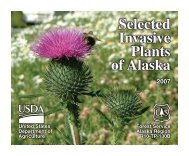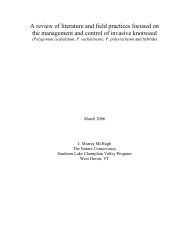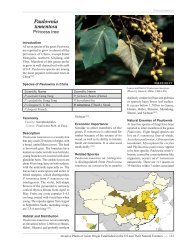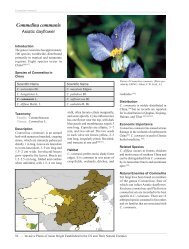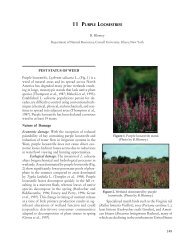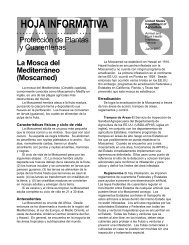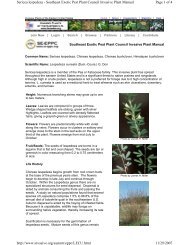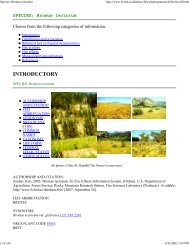Oviposition preference - Invasive.org
Oviposition preference - Invasive.org
Oviposition preference - Invasive.org
Create successful ePaper yourself
Turn your PDF publications into a flip-book with our unique Google optimized e-Paper software.
<strong>Oviposition</strong> <strong>preference</strong>: its definition,<br />
measurement and correlates, and its use in<br />
assessing risk of host shifts<br />
Michael C. Singer 1<br />
Summary<br />
To predict evolution in plant–insect systems we can begin by defining potentially heritable traits of<br />
plants that describe how they interact with insects and potentially heritable traits of insects that describe<br />
how they interact with plants. Examples are “acceptability” as a plant trait and “<strong>preference</strong>” as an insect<br />
trait. Some practical applications of this approach and of dissecting <strong>preference</strong> into its components are<br />
discussed. The question: Given one population of insects and 2 categories of plant, which category of<br />
plant do the insects prefer, and is this <strong>preference</strong> adaptive? seems like a simple question, but testing it<br />
can be confounded by two problems. First, plants vary both within and among species, and we don’t<br />
know how to classify them from the insects’ perspective. Second, insects vary along axes of <strong>preference</strong><br />
that we hadn’t imagined. An example is given from butterflies in which variation among insects in how<br />
they rank plant individuals (within species) can masquerade as variation in which species they prefer.<br />
An apparent solution to this problem would be to offer each insect a different, randomly chosen pair of<br />
plants in the two plant categories being compared. But insects don’t interact with plants at random in<br />
nature, and we show that forcing them to do so in an experiment generates misleading results.<br />
From a practical perspective I argue that risk assessment would benefit from incorporation of the<br />
concept of “motivation” alongside “<strong>preference</strong>” and that candidate species should be tested at<br />
maximum levels of motivation. I also describe how taking advantage of detailed behavioural traits of<br />
a study insect allows the development of a <strong>preference</strong>-testing technique. The technique itself may or<br />
may not transfer to other systems; what should transfer is the approach to exploiting natural traits of<br />
the insect, whatever they may be. This approach also includes a rationale for identifying and testing the<br />
assumptions underlying the design of a <strong>preference</strong> test.<br />
Introduction<br />
Critiques of biocontrol procedures have been based on<br />
observed use of non-target plants as hosts by introduced<br />
insect control agents (Louda et al. 1997). Such critiques<br />
underline the need to estimate as precisely as possible<br />
the risks that such events will occur (Zwölfer & Harris<br />
1971, McEvoy 1996, Simberloff & Stiling 1996,<br />
McFadyen 1998, Withers 1999, van Klinken &<br />
Edwards 2002). These efforts could involve estimating<br />
the likelihoods of acceptance of particular specified<br />
non-targets, and/or the general propensity of a candidate<br />
agent to expand its host range in a general sense.<br />
An important aspect of risk assessment is to understand<br />
the relationship between the results of <strong>preference</strong> tests<br />
performed on captive insects and the likelihood that<br />
1 Integrative Biology, University of Texas, Austin, TX 78712, USA.<br />
sing@mail.utexas.edu<br />
these insects would attack low-ranked (less-preferred)<br />
hosts in nature. Here, I discuss the definition and testing<br />
of <strong>preference</strong> and summarize prior work on the conceptual<br />
and practical separation between insect <strong>preference</strong><br />
and plant acceptability. I also consider the ways in<br />
which the internal state of the insect may affect its motivation,<br />
or readiness to feed or oviposit, and the manner<br />
in which the concept of “motivation” might be useful in<br />
risk assessment. Finally, I suggest that we do not yet<br />
know whether a monophagous population of an<br />
oligophagous species poses a greater risk as a candidate<br />
agent than an equally monophagous population of an<br />
entirely monophagous species.<br />
For many herbivorous insects, especially flying<br />
insects, oviposition <strong>preference</strong> is the principal mechanism<br />
by which the insect–host relationship is established.<br />
It is this trait of the insect that interacts with<br />
spatial distributions, abundances and acceptabilities of<br />
plants to generate patterns of insect–host association<br />
across the landscape. The arguments presented here,<br />
235
Proceedings of the XI International Symposium on Biological Control of Weeds<br />
developed specifically from studies of Melitaeine<br />
butterflies (genera Melitaea and Euphydryas), provide<br />
a worked example of how oviposition <strong>preference</strong> might<br />
be defined, measured and related to events in the field.<br />
Readers are left to deduce the extent to which these<br />
conceptual approaches and techniques may be useful<br />
for understanding the insects with which they work.<br />
Definitions of terms<br />
I use the following definitions, modified slightly from<br />
those suggested earlier (Singer 1982, 1986, 1994, 2000,<br />
Singer et al. 1992b):<br />
• An “encounter” occurs between plant and insect<br />
when the insect arrives at a distance from which it<br />
could perceive stimuli emanating from the plant.<br />
For example, an insect may encounter a plant visually,<br />
perceive it, approach or alight upon it and then<br />
encounter it chemically and physically.<br />
• “Acceptance” is a positive response made by an<br />
insect to a plant that has been encountered. For<br />
example, a flying insect may accept visual stimuli<br />
by turning towards a plant and alighting on it. The<br />
insect may then accept (or reject) contact chemical<br />
stimuli by feeding or ovipositing (or not).<br />
Insect traits:<br />
• “Motivation” is a general tendency to feed or<br />
oviposit, without reference to any particular host. A<br />
motivated insect is sensitive and responsive to<br />
stimuli that may lead it to feed or oviposit (Singer et<br />
al. 1992b).<br />
• “Perceptual ability” is the set of likelihoods of<br />
perceiving a particular specified set of plants that<br />
are encountered.<br />
• “Preference” is the set of likelihoods of accepting a<br />
particular specified set of resources that are<br />
perceived (Singer 1986, 2000). In practice, it would<br />
normally be measured as the set of likelihoods of<br />
accepting resources that are encountered. One<br />
aspect of <strong>preference</strong> is “host range”, the set of<br />
plants that would be accepted under specified conditions.<br />
In a conservative assessment of a candidate<br />
agent we should be principally interested in the host<br />
range at maximum motivation.<br />
• “Specificity” has been defined (Singer 1982, 1986)<br />
and used by some biologists (e.g. Courtney et al.<br />
1989, Thompson 1998) to mean the strength of<br />
<strong>preference</strong>, regardless of its direction. However, this<br />
usage has not become well-established and there are<br />
several current uses of “specificity”. It is sometimes<br />
synonymous simply with “host affiliation” or with<br />
“insect diet” and sometimes has a wider meaning<br />
incorporating both <strong>preference</strong> and performance<br />
(van Klinken & Edwards 2002).<br />
Plant traits:<br />
• “Apparency” is the set of likelihoods that a plant<br />
will be perceived by a specified set of insects (Feeny<br />
1976, Singer 1986).<br />
• “Acceptability” is the set of likelihoods that a plant<br />
will be accepted after being encountered by a specified<br />
insect or set of insects (Singer 1986, 2000).<br />
The definition given here renders “<strong>preference</strong>” a<br />
useful trait in thinking about the potential for evolutionary<br />
change because it is a trait of the insect whose<br />
variation can be measured among individuals and<br />
populations. In contrast, “<strong>preference</strong>” is often defined<br />
by ecologists as the proportion of a particular resource<br />
in the diet as a function of the availability of that<br />
resource in the habitat (Hassell & Southwood 1978,<br />
Crawley 1984). This ecologically important parameter<br />
is an emergent trait of the plant–insect interaction rather<br />
than a trait of insect or plant (Singer & Parmesan 1993,<br />
Singer 2000). A partial solution to the difficulty posed<br />
by the diversity of meanings of “<strong>preference</strong>” is to use<br />
the term “electivity” (Ivlev 1961, Singer 2000) for the<br />
ecological parameter and “<strong>preference</strong>” for the behavioural<br />
parameter.<br />
With the definition of “<strong>preference</strong>” used here, experiments<br />
in which an insect is offered a single plant (nochoice<br />
tests) should not strictly be called tests of “<strong>preference</strong>,”<br />
although a series of such tests might be so<br />
called. An insect cannot have a “<strong>preference</strong>” for a<br />
single resource. We might better describe it as having<br />
an “affinity” for such a resource.<br />
Sequence of events in host search by<br />
Melitaeine butterflies: responses to<br />
visual, chemical and physical stimuli<br />
I’ll begin with a description of the oviposition behaviour<br />
of our study insects, from which our conceptual<br />
approaches have been derived. While the results of this<br />
study may not be directly applicable to different types<br />
of insect, the approach and manner of analysis could be<br />
more widely relevant. In Euphydryas editha at Rabbit<br />
Meadow, Sequoia National Forest, California, alighting<br />
was primarily or entirely in response to visual stimuli,<br />
as evidenced by strong relationships between fixed<br />
(non-learned) alighting bias and plant visual traits<br />
(Parmesan et al. 1995). After tasting a plant and finding<br />
it chemically acceptable, the Melitaeine curls its<br />
abdomen under a leaf, extrudes its ovipositor, and<br />
probes the lower surface of the leaf. This probing is<br />
clearly a response to chemistry because it can be stimulated<br />
by placing the insect on a dampened filter paper<br />
on which an ethanol wash of host leaf surface has been<br />
evaporated. There is apparently no chemical sense on<br />
the ovipositor: eggs are readily laid on non-host or even<br />
non-plant material, all that is necessary is that the tarsi<br />
of the insect contact the host; the ovipositor does not<br />
need to do so. Once the plant has been chemically<br />
236
<strong>Oviposition</strong> <strong>preference</strong> and the risk of host-shifts<br />
accepted, oviposition depends principally on physical<br />
features of the site such as the size, shape and orientation<br />
of the leaf and the extent to which it yields when<br />
pressed by the ovipositor.<br />
Pre-alighting butterfly <strong>preference</strong> and host<br />
apparency<br />
Apparency was first visualized by Feeny (1976) as a<br />
property of a plant that influenced its susceptibility to<br />
being found by herbivores. Singer (1986) defined it as<br />
the set of likelihoods that a plant will be perceived by<br />
some specified insect or set of insects. The property of<br />
the insect that interacts with plant apparency is the<br />
insect’s perceptual ability, defined here as the set of<br />
likelihoods of perceiving a particular specified set of<br />
plants that are encountered. The concept of apparency<br />
has fallen into disuse. This may be because apparency<br />
is, in practice, hard to measure and/or to separate from<br />
perceptual ability. We usually cannot tell whether an<br />
insect that passes over a plant without stopping fails to<br />
perceive the plant or perceives it and decides against<br />
alighting on it. Whether or not the plant is perceived<br />
depends on an interaction between insect perceptual<br />
ability and plant apparency. Whether or not the insect<br />
alights on a plant that it has perceived depends on an<br />
interaction between the insects’ pre-alighting host <strong>preference</strong><br />
and plant acceptability.<br />
With present knowledge and techniques these<br />
factors may be difficult or impossible to tease apart in<br />
practice. However, defining them in principle is, I<br />
think, useful to help generate the incentive to understand<br />
the mechanisms at work. In one case, our group<br />
has made progress in identifying pre-alighting <strong>preference</strong><br />
rather than the apparency/perceptual ability relationship<br />
as a cause of observed patterns of alighting. E.<br />
editha at Rabbit Meadow had added to their diet a novel<br />
host, Collinsia torreyi, just a few (
Proceedings of the XI International Symposium on Biological Control of Weeds<br />
1992b), a technique that overcomes the problem of low<br />
egg cluster number by staging a series of encounters<br />
between a butterfly and test plants and using as data the<br />
results of each encounter, while preventing the insects<br />
from actually ovipositing. An insect that is not allowed<br />
to oviposit will continue to show acceptances and rejections<br />
of plants that it encounters, thereby providing<br />
more information than could have been obtained from<br />
a single oviposition.<br />
This test takes advantage of the manipulability of<br />
Melitaeines. A female placed gently on a host, either in<br />
the field or in the greenhouse, appears to behave as<br />
though she had naturally alighted on that host. But does<br />
she? Indeed she does! Rausher et al. (1981) found that<br />
manipulated butterflies duplicated the choices they had<br />
made before they had been captured.<br />
A second test of the relevance of manipulated trials<br />
to actual host use was made by testing the <strong>preference</strong>s<br />
of insects captured naturally ovipositing on different<br />
species at the same site (Singer 1983, Singer et al.<br />
1993). There was a strong association between the<br />
tested <strong>preference</strong>s and the observed ovipositions.<br />
Again, this shows that a test using manipulated butterflies<br />
measures something that is connected with the<br />
observed variation of host use.<br />
How to perform a sequential choice test<br />
Manipulated tests are clearly pertinent to events in<br />
the field. What are the actual procedures involved in the<br />
testing? Each insect is offered a series of staged<br />
encounters at, say, 15-minute intervals. Each encounter<br />
lasts a maximum of three minutes. Acceptance is<br />
judged from pressing of the extruded ovipositor against<br />
the plant for a count of three. Rejection is the absence<br />
of this behaviour during the entire three-minute period.<br />
An insect that accepts is not allowed to oviposit, but is<br />
manually removed from the plant before the first egg<br />
has been laid.<br />
The test is based on the observation that, as time<br />
passes, the probability that a particular plant would be<br />
accepted, if it were encountered, jumps from 0 to<br />
almost 1 very rapidly, in the space of just a few minutes<br />
(Singer 1982). That probability then remains close to 1,<br />
at least during the principal hours when oviposition is<br />
likely (noon to 4pm) until oviposition occurs. Suppose<br />
that an insect is offered the same plant over and over<br />
and over and over and over again, in repeated staged<br />
encounters, and is prevented from actual oviposition as<br />
described above. There is a rejection phase when the<br />
plant is consistently rejected, followed by an acceptance<br />
phase when the plant is accepted about 95% of the<br />
time (Singer 1982). Now suppose that the same insect<br />
is offered staged encounters with two plants, X and Y,<br />
in alternation. If we indicate a rejection by R and an<br />
acceptance by A, we may observe one of three types of<br />
sequence, shown below. Each acceptance or rejection<br />
in these sequences is the result of an entire three-minute<br />
trial, with no account taken of the time to acceptance<br />
within any such trial:<br />
1. RX; RY; RX; RY; RX; AY; RX; AY; RX; AY; AX;<br />
AY; AX; AY; AX<br />
2. RX; RY; AX; RY; AX; RY; AX; RY; AX; RY; AX;<br />
RY; AX; RY; AX; AY<br />
3. RX; RY; RX; RY; RX; RY; RX; RY; AX; AY; AX;<br />
AY; AX; AY; AX; AY<br />
This procedure would constitute a sequential choice<br />
test. In case (1) we would say that Y is preferred<br />
because X is rejected in encounters that follow acceptance<br />
of Y. In case (2) X is preferred, and in case (3) no<br />
<strong>preference</strong> is detected.<br />
To the extent that the behaviour of manipulated<br />
butterflies really represents what they would do if they<br />
were at liberty, then the result shown in (1) estimates<br />
the length of time that a butterfly would search in the<br />
motivational state where encounter with Y but not X<br />
would result in oviposition, before reaching the motivation<br />
at which either X or Y would be accepted, whichever<br />
were the next plant to be encountered. This length<br />
of time is called the “discrimination phase” (Figure 1).<br />
It is a measure of the strength of <strong>preference</strong> for Y over<br />
X. The discrimination phase in (1) is shorter than that in<br />
(2), so the <strong>preference</strong> for Y over X shown in (1) is<br />
weaker than the <strong>preference</strong> for X over Y in (2).<br />
Because the insect cannot be offered continuous<br />
exposure to both plants, the length of the discrimination<br />
phase cannot be measured precisely. Its minimum length<br />
is the time difference between the first acceptance of the<br />
preferred host and the last rejection of the second-ranked<br />
host. In practice, this minimum length is the value that<br />
has been used, partly because the maximum cannot be<br />
estimated for insects that never accept the second-ranked<br />
host. Use of the minimum value gives us the freedom, if<br />
we so choose, to utilize data from butterflies that escape<br />
or die under interrogation, before they have accepted all<br />
the hosts in the test series.<br />
It is impossible to estimate the length of a discrimination<br />
phase unless one begins the test sequence before<br />
any of the test plants are acceptable. If the first staged<br />
encounter with just one of the test plants results in<br />
acceptance, then the discrimination phase has already<br />
begun. If this happens, it may be possible to obtain a<br />
rank order of <strong>preference</strong>, but estimation of discrimination<br />
phase length requires allowing the insect to<br />
oviposit and recommencing the test. The test, once<br />
begun, should ideally not be interrupted. An insect that<br />
rejects both test plants before such an interruption may<br />
switch directly to accepting them both when testing<br />
recommences. In such a case the opportunity to<br />
discover which plant would have been accepted first<br />
has been lost. The insect should be allowed to oviposit<br />
and its test re-started.<br />
238
<strong>Oviposition</strong> <strong>preference</strong> and the risk of host-shifts<br />
Figure 1.<br />
Stylized depiction of changes in responses of insects to two plants, when<br />
repeated encounters are staged and oviposition is NOT allowed. Records<br />
are shown for three butterflies, each of which prefers plant A over plant B.<br />
Discrimination phases are indicated by “DP”. (Modified from Singer et al.<br />
1992b.)<br />
Expressing the results of the sequential<br />
choice test<br />
The original description of the sequential choice test<br />
(Singer 1982) suggested that the test allowed <strong>preference</strong><br />
to be described in two ways. The “rank order” of <strong>preference</strong><br />
is the order in which the different plants are first<br />
accepted, while the strength of <strong>preference</strong> or “specificity”<br />
is estimated from the length of the discrimination<br />
phase. This distinction has been adopted by some<br />
authors who have found it useful in order to argue that<br />
rank order is more highly conserved in evolution than<br />
strength of <strong>preference</strong> (Courtney et al. 1989, Thompson<br />
1993). In Melitaeines both aspects of <strong>preference</strong> can<br />
vary simultaneously, giving rise to a bell-curve of <strong>preference</strong>s<br />
(Figure 2). In this figure, specificity is depicted<br />
as the distance along the abscissa from the “no <strong>preference</strong>”<br />
point, and “rank order” is opposite on either side<br />
of this point. The minimum length of discrimination<br />
phase, again on the abscissa, is determined using only<br />
time differences during the period (11:30am to 4:30pm)<br />
when oviposition is likely. Therefore 5 hours in the<br />
figure is equivalent to 1 day, 10 hours to 2 days, etc.<br />
Figure 2 shows that the range of plants that would be<br />
accepted, if they were encountered, expanded at<br />
different rates in different individual butterflies sampled<br />
from the same population. In E. editha this type of variation<br />
is heritable (Singer et al 1988), and responds<br />
rapidly to natural selection (Singer et al. 1993).<br />
Assumptions of the sequential choice test<br />
Any <strong>preference</strong> test carries baggage in the form of<br />
assumptions of varying testability, and ours, alas, is no<br />
exception! The following section identifies some of our<br />
assumptions and discusses the extent to which they<br />
have been tested.<br />
Assumption 1. There is a precise time at which an<br />
insect switches from a “rejection phase”, during which<br />
a particular plant would be consistently rejected if<br />
encountered, to an “acceptance phase”, during which<br />
that plant would be consistently accepted. The timing of<br />
the switch from rejection to acceptance differs in<br />
responses to different plant categories. If this assumption<br />
were not true, the “discrimination phase” would<br />
not be real. How true is it? This can be tested by asking<br />
what is the frequency of rejection of plants that have<br />
been previously accepted, when no oviposition has<br />
intervened. For plants that were moderately or highly<br />
acceptable to the insects, the frequency of such rejections<br />
was typically 5% or less, but in one case a plant<br />
that was first accepted several days after the highestranked<br />
host was never consistently accepted (Singer<br />
1982). For most hosts, a plant that had been accepted<br />
was accepted again with about 95% probability,<br />
provided that no oviposition had occurred, that there<br />
was no adverse change in the weather and that the end<br />
of the day was not at hand.<br />
Assumption 2. When a test covers more than one<br />
day, we assume that the motivational state of the<br />
butterfly at the beginning of the second day’s test is the<br />
same as its motivational level at the end of the first<br />
day’s test. This is not easy to test, and we have not<br />
explicitly tested it, but the behaviour of E. editha is<br />
consistent with the assumption in the following<br />
manner. When we commence testing at some time<br />
between 11:30 and noon, we usually observe that the<br />
range of plants that are accepted resembles the range<br />
that had been accepted at 4pm the previous afternoon.<br />
It is unusual for additional plants to be accepted at this<br />
239
Proceedings of the XI International Symposium on Biological Control of Weeds<br />
Figure 2.<br />
Distribution of measured discrimination phases at Rabbit Meadow in<br />
1981. Lumped data from two adjacent habitat patches, one where Collinsia<br />
was used and one where Pedicularis was used. (Modified from Singer<br />
1983.)<br />
time, or for plants to be rejected that had been accepted<br />
the day before. We tentatively conclude that the<br />
passage of time between 4:30pm and 11:30am has little<br />
effect, and time during this period is not included in the<br />
calculation of the discrimination phases.<br />
Assumption 3. We assume that an encounter with<br />
plant A at time 1 has no effect on the insect’s responses<br />
to either plant A or plant B at some subsequent time.<br />
This assumption is obviously violated when a butterfly<br />
has just accepted a host and is transferred quickly to<br />
another one. There is a clear “carry-over” effect making<br />
the second host much more likely to be accepted than if<br />
the butterfly were made to fly or allowed to rest in a<br />
cage with no hosts for a few minutes. Therefore, when<br />
we observe an acceptance, we allow the insect at least<br />
five minutes’ rest before testing another plant.<br />
Apart from this effect, experiments consistently fail<br />
to show any effect of manipulated experience on host<br />
acceptance. Two such experiments are described<br />
below:<br />
a) We collected wild females each morning at Rabbit<br />
Meadow and split them into two groups. One group<br />
was offered 9–10 repeated encounters with C<br />
(Collinsia), the other with P (Pedicularis). In the<br />
afternoon of the same day all butterflies were<br />
offered the same test plant species. This test plant<br />
was sometimes C and sometimes P, on alternate<br />
days. So, each day’s experiment asked whether<br />
butterflies with different recent experience of host<br />
encounter differed in their responses to a single test<br />
plant. No such effects were found (Thomas &<br />
Singer 1987)<br />
b) We collected teneral females (as mating pairs with<br />
no prior host encounter) at Rabbit Meadow and<br />
offered some of them alternating encounters with P<br />
and C, while others were offered only C or only P.<br />
We then offered each insect a single test with either<br />
C or P on the afternoon of the second day of its<br />
adult life. Again, no effects were detected (Singer<br />
1986).<br />
Assumption 4. Handling the butterflies does not<br />
affect their responses. In fact, handling does have a<br />
clear effect: it increases the likelihood of oviposition. A<br />
butterfly can be “encouraged” to oviposit by being<br />
picked up and quickly replaced on the test plant.<br />
Perhaps picking the insects up and replacing them<br />
makes them respond as though they were encountering<br />
plants more frequently, and they may be sensitive to<br />
plant density. We don’t know. Our method of dealing<br />
with this violation of assumption 4 is that, whenever an<br />
insect appears to be rejecting a plant, she is picked up<br />
and replaced at least three times during each threeminute<br />
staged “encounter”, before the result of the test<br />
is recorded as rejection. By this means we attempt to<br />
“encourage” oviposition equally in all of our test<br />
subjects.<br />
It is clear from this account that the assumptions of<br />
our technique are to some extent violated, and that<br />
subjectivity cannot be totally eliminated from these<br />
sequential choice trials. We cannot be sure of the exact<br />
relationship between the test results and the behaviour<br />
of the butterflies in the field. However, several tests<br />
have shown that variation among individuals or populations<br />
in natural behavior in the field is parallelled by<br />
variation in the results of <strong>preference</strong> tests administered<br />
subsequently (Rausher et al. 1981, Singer et al. 1993).<br />
Distinguishing in practice between<br />
“<strong>preference</strong>” and “motivation”<br />
Starting with Dethier’s (1959) paper on “mistakes”<br />
made by ovipositing butterflies and continuing to the<br />
240
<strong>Oviposition</strong> <strong>preference</strong> and the risk of host-shifts<br />
present day, there has been continued discussion in the<br />
literature about the frequency with which insects<br />
oviposit on hosts that are suboptimal, hosts that are not<br />
preferred, or even on non-hosts that are toxic (Chew &<br />
Robbins 1984, Feldman & Haber 1998). These discussions<br />
have often involved questions about the roles<br />
played by unusual oviposition events in evolution of<br />
diet (Thomas et al. 1987). Perhaps such events are preludes<br />
to host-shifts? Whether or not this is true depends<br />
on the behavioural mechanisms that cause unusual<br />
ovipositions and on the likelihood that insects<br />
performing such unusual acts do so because of heritable<br />
<strong>preference</strong>s (Karowe 1990, van Klinken 2000).<br />
In this context our ability to test <strong>preference</strong>s of<br />
freshly-captured Melitaeines in the field has enabled us<br />
to investigate the behavioural mechanisms that underlie<br />
observations of natural oviposition on low-ranked<br />
hosts. Why might a Melitaeine be found ovipositing on<br />
a plant other than its preferred host? There are two<br />
possibilities. First, the insect has been searching for a<br />
long time without finding its preferred host. Second, its<br />
discrimination phases are short and it does not search<br />
for long before it would accept a second or third-ranked<br />
host. In the first case, we could describe the butterfly as<br />
highly motivated to oviposit. In the second, we could<br />
say that its <strong>preference</strong> is weak or its specificity is low.<br />
Why should we bother to make this distinction? The<br />
evolutionary consequences are different in the two<br />
cases. Differences among individuals in motivation<br />
caused by differences in length of search are not likely<br />
to be heritable, while differences in length of discrimination<br />
phase could be heritable, and indeed, are likely<br />
to be so (Singer et al. 1988, 1992b). This argument is<br />
pertinent to questions about the consequences of a<br />
single event in which an introduced agent feeds on a<br />
non-target plant.<br />
To clarify the distinction between <strong>preference</strong> and<br />
motivation, I have depicted in Figure 1 (taken from<br />
Singer et al. 1992b) stylized records for three butterflies,<br />
two of which (#2 and # 3) differ in motivation but<br />
not in <strong>preference</strong> and two of which (#1 and #2) differ in<br />
strength of <strong>preference</strong> but not in motivation. The figure<br />
indicates that, at 13.50h, butterfly 3 would accept plant<br />
A if that plant were encountered, but butterfly 2 would<br />
reject it. This would be ascribed to the difference in<br />
motivation. At 14.50h, butterfly 2 would reject plant B<br />
while butterfly 1 would accept it. This would be<br />
ascribed to their difference in strength of <strong>preference</strong>.<br />
We have shown experimentally that variation of motivation<br />
and of <strong>preference</strong> occur simultaneously in the<br />
field and that these variables can be teased apart (Singer<br />
et al. 1992b).<br />
Correlates of <strong>preference</strong><br />
1. Relationship of <strong>preference</strong> to fecundity<br />
Preference is often thought to be driven by<br />
“eggload”. An insect that feels increasing “egg pressure”<br />
might be increasingly motivated to oviposit.<br />
Differences among individuals in fecundity or rate of<br />
egg maturation would then generate differences in<br />
strength of oviposition <strong>preference</strong> (Courtney & Hard<br />
1990). However, we (Agnew & Singer 2000) suspected<br />
that several of these conclusions had been derived from<br />
incorrect attributions of cause to observed correlations<br />
in the field. In our own study insects, the individuals<br />
that matured eggs fastest were not the individuals with<br />
the fastest increase in their range of accepted hosts.<br />
2. Relationship of maternal <strong>preference</strong> to<br />
offspring performance<br />
Discussion of relationships between <strong>preference</strong> and<br />
performance typically confounds several different<br />
questions. Three of the most important ones are:<br />
1. Is <strong>preference</strong> correlated with performance among<br />
populations? In other words, is <strong>preference</strong> variation<br />
among populations associated with performance<br />
variation in the same set of populations?<br />
2. Is <strong>preference</strong> correlated with performance within<br />
populations? In other words, do individual mothers<br />
with particular <strong>preference</strong>s produce offspring with<br />
particular performances?<br />
3. Is host choice adaptive at the population level? To<br />
what extent is the rank order of plants in the insects’<br />
<strong>preference</strong> hierarchy concordant with the rank order<br />
of the same plants in their ability to support larval<br />
growth and survival (cf Wiklund 1975, Jaenike<br />
1990, Mayhew 1997)?<br />
All three of these types of correlation occur in E.<br />
editha (Rausher et al. 1981, Ng 1988, Singer et al.<br />
1988, 1994). The second type even occurs with respect<br />
to variation among individual host plants (Ng 1988).<br />
3. Correlations among <strong>preference</strong>s<br />
Preference for A versus B may not be independent of<br />
<strong>preference</strong> for C versus D (Courtney et al. 1989). Then<br />
again, it may be! (Singer et al. 1992a).<br />
Novel axes of variation revealed by<br />
<strong>preference</strong>-testing of Melitaeines<br />
Melitaeines make substantial discriminations within as<br />
well as among host species. This process generates<br />
complexity because discrimination within species is not<br />
nested within discrimination among species, as one<br />
might reasonably expect. Preference-testing of insects<br />
on conspecific and heterospecific plants has revealed<br />
novel axes of variation, the existence of which threatens<br />
241
Proceedings of the XI International Symposium on Biological Control of Weeds<br />
many standard and apparently sensible experimental<br />
designs. Three examples are discussed below.<br />
1. Individual Melitaea cinxia butterflies varied in the<br />
relative importance they assigned to variation<br />
within and among host species (Singer & Lee<br />
2000). Singer & Lee showed how variation in<br />
discrimination within plant species might falsely<br />
appear as variation in discrimination among<br />
species. This could be an important, general and<br />
overlooked problem in experimental design.<br />
2. When Euphydryas aurinia butterflies and their<br />
hosts were sampled randomly, we obtained the odd<br />
result that insects from populations feeding on<br />
Gentiana, Lonicera and Cephalaria all preferred<br />
over their own hosts a plant species, Succisa pratensis,<br />
that they never encountered in the field<br />
(Singer et al. 2002). This appearance of maladaptation<br />
was an artefact of sampling host populations at<br />
random. It disappeared when the populations were<br />
sampled differently, using naturally-accepted plants<br />
(Singer et al. 2002). This result casts doubt on<br />
experiments that ask whether host choice is adaptive<br />
by manipulating insects to feed on randomlychosen<br />
members of different host species. Alas, this<br />
category includes many of our own experiments<br />
(e.g. Singer et al. 1994).<br />
3. E. editha at Rabbit Meadow were offered Pedicularis<br />
plants in sequential choice trials. Newly hatched<br />
larvae were then placed on the plants to ask whether<br />
plants that were generally preferred supported higher<br />
offspring survival. They did not (Ng 1988). However,<br />
this apparently simple result, that discrimination is<br />
NOT adaptive, disguised an unexpected complexity.<br />
Individuals that discriminated among Pedicularis<br />
plants produced offspring that survived better on<br />
plants preferred by discriminating individuals.<br />
Offspring of insects that did not discriminate<br />
survived equally well on plants accepted or rejected<br />
by discriminators (Ng 1988). If we put the question<br />
in the form: “are the plants that are most acceptable<br />
in a general sense also the most suitable in some<br />
general sense?” we get a misleading result!<br />
These three effects create considerable difficulties<br />
for the design of experiments that manipulate plants<br />
and insects into specific interactions and then examine<br />
the consequences of those interactions for either or both<br />
partners.<br />
Conclusions<br />
Changes in oviposition <strong>preference</strong> are intimately<br />
involved in observed diet shifts in nature (Singer et al.<br />
1993, Singer & Thomas 1996). These natural observations<br />
validate the approach of incorporating detailed<br />
studies of <strong>preference</strong> in risk-assessment (e.g. Heard &<br />
van Klinken 1998, Barton-Browne & Withers 2002).<br />
Here, I have described the approach to defining and<br />
measuring <strong>preference</strong> that our group has developed in<br />
working with populations of Melitaeine butterflies.<br />
This approach first introduced the role of time since last<br />
oviposition (TSLO) as an important cause of changes in<br />
host acceptance (Singer 1982, 1986). For reasons<br />
detailed earlier in the report, we have chosen to<br />
describe these time-dependent changes in observed<br />
host range as driven by changes in motivation, and to<br />
define “<strong>preference</strong>” independently of motivation. So,<br />
when an insect that is deprived of opportunity to feed<br />
undergoes physiological changes that cause it to accept<br />
a wider range of hosts, this is a change in motivation. Its<br />
<strong>preference</strong> is measured by the manner in which these<br />
changes occur. Learning (Cunningham et al. 1999)<br />
influences <strong>preference</strong> and thereby affects the relationship<br />
between motivation and acceptance.<br />
While the detail of this study may not be broadly<br />
applicable, what are the more general messages of this<br />
approach for risk assessment? First, that candidate<br />
insects should be tested at the maximum levels of motivation<br />
that they are likely to attain in the field. In many<br />
cases we don’t know what conditions maximize motivation,<br />
so this requires study. Time of day, insect age<br />
and body temperature may be important. In insects<br />
whose motivation varies with TSLO, as do our study<br />
insects, maximizing motivation entails prolonged<br />
testing with deprivation of opportunity to feed or<br />
oviposit, as suggested by Barton-Browne & Withers<br />
(2002). No-choice tests are useful in this context since<br />
allowing feeding/oviposition on a preferred resource<br />
may hold motivation to low levels at which low-ranked<br />
resources are not accepted. In any case, insects<br />
normally encounter plants sequentially rather than<br />
simultaneously. What may appear to the experimenter<br />
to be a choice situation may from the insects’ perspective<br />
be a series of no-choice situations. Even when<br />
choice tests in which test plants are juxtaposed<br />
resemble natural situations that occur frequently, they<br />
don’t represent all the natural conditions. Some individual<br />
insects are sure to wander away from the hosts<br />
on which they developed, encounter habitats that don’t<br />
contain those hosts, and experiment with hosts that they<br />
would not have attacked if they had stayed at home<br />
(Thomas et al. 1987; Singer et al. 1992b). Situations are<br />
bound to occur where the control agent is exposed to<br />
the non-target plants and not to the target. The important<br />
question then becomes, not which plant is<br />
preferred, but whether the non-target is acceptable to<br />
the insect in a no-choice situation. For this purpose nochoice<br />
tests are the tests of choice (cf Hill 1999).<br />
A second question that arises from our work is this:<br />
do we have any use for species such as E. editha, in<br />
which populations may be either oligophagous or<br />
monophagous? In other words, is a monophagous<br />
population of an oligophagous species useless as a<br />
candidate agent, despite its population-level<br />
monophagy? Our <strong>preference</strong> testing shows that a<br />
sample taken from a monophagous population may<br />
comprise entirely insects that would search for several<br />
242
<strong>Oviposition</strong> <strong>preference</strong> and the risk of host-shifts<br />
days for their preferred host species before accepting a<br />
second choice. These are specialized insects that might<br />
indeed be suitable candidate agents. But would such a<br />
population be more likely to indulge in a host shift<br />
because it is sampled from an oligophagous species<br />
rather than from a monophagous one? The answer to<br />
this question isn’t known, but is susceptible to analysis<br />
by molecular phylogenetic techniques. Pending such<br />
analysis, all we can say is that when these insects have<br />
undertaken host shifts in the past they haven’t necessarily<br />
speciated. We can’t say that host shifts have<br />
occurred with higher frequency over time than in other<br />
groups of insects that have speciated with each host<br />
shift. If I continue this line of reasoning further, I’ll get<br />
into discussion of the definition of “species”, which lies<br />
far outside the purview of this paper. However, as<br />
several recent works (e.g. Hoffman et al. 2002) indicate,<br />
we should not worry too much about how to define<br />
species, host races and biotypes, but we SHOULD<br />
worry that the candidate agents that are introduced<br />
belong to EXACTLY the same entity, be it a species, a<br />
biotype or a host race, that has been subjected to specificity<br />
testing. Insects vary among populations in their<br />
host adaptations, and we should never assume that a<br />
sample originating from one population will behave in<br />
the same way as the same “species” sampled elsewhere.<br />
Acknowledgements<br />
The sections on definition and measurement of <strong>preference</strong><br />
are only slightly modified from material on the<br />
same topic in Chapter 6 of “On the Wings of Checkerspots:<br />
a model system for population biology” edited by<br />
Paul R. Ehrlich and Ilkka Hanski and due to be<br />
published by Oxford University Press in 2004. I am<br />
most grateful to the <strong>org</strong>anisers of Weed Symposium<br />
2003 for inviting me to contibute, and particularly to<br />
Toni Withers, Jim Cullen, Tim Heard and John Scott<br />
for detailed discussions. The development of the ideas<br />
presented here was much helped by collaborations with<br />
Duncan Mackay, Rick Moore, Camille Parmesan,<br />
Chris Thomas and Davy Boughton.<br />
References<br />
Agnew, K. & Singer, M.C. (2000) Does fecundity constrain the<br />
evolution of insect diet? Oikos 88, 533–538.<br />
Barton-Browne, L. & Withers, T.M. (2002) Time-dependent<br />
changes in the host-acceptance threshold of insects: implications<br />
for host specificity testing of candidate biological<br />
control agents. Biocontrol Science and Technology 12, 677-<br />
693.<br />
Bossart, J.L. & Scriber, J.M. (1995) Maintenance of ecologically<br />
significant genetic variation in the tiger swallowtail<br />
butterfly through differential selection and gene flow.<br />
Evolution 49, 1163–1171.<br />
Chew F.S. & Robbins, R.K. (1984) Egg laying in butterflies. in:<br />
The Biology of Butterflies, Symposia of the Royal Entomological<br />
Society 13, (ed I. Vane-Wright & P. Ackery), pp 65–<br />
79.<br />
Courtney, S.P., Chen, G.K. & Gardner, A. (1989) A general<br />
model for individual host selection. Oikos 55, 55–65.<br />
Courtney, S.P. & Hard, J. (1990) Host acceptance and lifehistory<br />
traits in Drosophila busckii: tests of the hierarchythreshold<br />
model. Heredity 64, 371–375.<br />
Crawley, M.J. (1984) Herbivory. Blackwells, Oxford.<br />
Cunningham, J.P., Zalucki, M.P. & West, S.A. (1999) Learning<br />
in Helicoverpa armigera (Lepidoptera: Noctuidae): a new<br />
look at the behaviour and control of a polyphagous pest.<br />
Bulletin of Entomological Research 89, 201–207.<br />
Dethier, V.G. (1959) Egg-laying habits of Lepidoptera in relation<br />
to available food. Canadian Entomologist 91, 554–561.<br />
Feeny, P.P. (1976) Plant apparency and chemical defense.<br />
Recent Advances in Phytochemistry 10, 1–40.<br />
Feldman, T.S. & Haber, W.A. (1998) <strong>Oviposition</strong> behaviour,<br />
host plant use and diet breadth of Anathassa butterflies<br />
(Lepidoptera: Nymphalidae) using plants in the Acanthaceae<br />
in a Costa Rican community. Florida Entomologist<br />
81, 396–406.<br />
Hassell, M.P. & Southwood, T.R.E. (1978) Foraging strategies<br />
of insects. Annual Reviews of Ecology & Systematics 9, 75–<br />
98.<br />
Heard, T.A. & van Klinken, R.D. (1998) An analysis of designs<br />
for host range tests of insects for biological control of weeds.<br />
Pest Management – Future Challenges, Sixth Australasian<br />
Applied Entomology Research Conference Vol 1, (eds M.P.<br />
Zalucki, R.A.I. Drew & G.G. White), pp 539–546. University<br />
of Queensland Printery, Brisbane.<br />
Hill, R.L. (1999) Minimizing uncertainty – in support of nochoice<br />
tests. in Host Specificity Testing in Australasia:<br />
Towards Improved Assays for Biological Control. (eds T.M.<br />
Withers, L. Barton Browne & J. Stanley), pp. 1–10. Scientific<br />
Publishing, Queensland Department of Natural<br />
Resources, Brisbane.<br />
Hoffman, J.H., Impson, F.A.C. & Volchansky, C.R. (2002)<br />
Biological Control of cactus weeds: Implications of hybridization<br />
between control agent biotypes. Journal of Applied<br />
Ecology 39, 900–908.<br />
Ivlev, V.S. (1961) Experimental ecology of the feeding of fishes.<br />
Yale University Press, New Haven, USA.<br />
Jaenike, J. (1990) Host specialization in phytophagous insects.<br />
Annual Reviews of Ecology and Systematics 21, 243–273.<br />
Karowe, D.N. (1990) Predicting host range evolution: colonization<br />
of Coronilla varia by Colias philodice (Lepidoptera:<br />
Pieridae). Evolution 44, 1637–1647.<br />
van Klinken, R.D. (2000) Host-specificity constrains evolutionary<br />
host change in the psyllid Prosopidopsylla flava.<br />
Ecological Entomology 25, 413–422.<br />
van Klinken, R.D. & Edwards, O.R. (2002) Is host-specificity of<br />
weed biological control agents likely to evolve rapidly<br />
following establishment? Ecology Letters 5, 590–596.<br />
Louda, S.M., Kendall, D., Connor, J. & Simberloff, D. (1997)<br />
Ecological effects of an insect introduced for the biological<br />
control of weeds. Science 277, 1088–1090.<br />
Mackay, D.A. (1985) Prealighting search behaviour and host<br />
plant selection by ovipositing Euphydryas editha butterflies.<br />
Ecology 66, 142–151.<br />
Mayhew, P.J. (1997) Adaptive patterns of host-plant selection<br />
by phytophagous insects. Oikos 79, 417–428.<br />
McEvoy, P. (1996) Host specificity and biological control: how<br />
well is research on host specificity addressing the potential<br />
risks of biological control? BioScience 46, 401–405.<br />
McFadyen, R.E.C. (1998) Biological control of weeds. Annual<br />
Review of Entomology 43, 369–393.<br />
243
Proceedings of the XI International Symposium on Biological Control of Weeds<br />
Ng, D. (1988) A novel level of interactions in plant–insect<br />
systems. Nature 334, 611–612.<br />
Parmesan. C. (1991) Evidence against plant “apparency” as a<br />
constraint on evolution of insect search efficiency. Journal<br />
of Insect Behaviour 4, 417–430.<br />
Parmesan, C., Singer, M.C. & Harris, I. (1995) Absence of<br />
adaptive learning from the oviposition foraging behaviour of<br />
a checkerspot butterfly. Animal Behaviour 50, 161–175.<br />
Rausher, M.D., Mackay, D.A. & Singer, M.C. (1981) Pre- and<br />
post-alighting host discrimination by Euphydryas editha<br />
butterflies: the behavioural mechanisms causing clumped<br />
distributions of egg clusters. Animal Behaviour 29, 1220–<br />
1228.<br />
Simberloff, D. & Stiling, P. (1996) How risky is biological<br />
control? Ecology 77, 1965–1974.<br />
Singer, M.C. (1982) Quantification of host <strong>preference</strong> by<br />
manipulation of oviposition behaviour in the butterfly<br />
Euphydryas editha. Oecologia 52, 224–229.<br />
Singer, M.C. (1983) Determinants of multiple host use by a<br />
phytophagous insect population. Evolution 37, 389–403.<br />
Singer, M.C. (1986) The definition and measurement of oviposition<br />
<strong>preference</strong>. Plant–Insect Interactions, (eds J. Miller &<br />
T.A. Miller), pp 65–94. Springer-Verlag, Berlin.<br />
Singer, M.C. (1994) Behavioural constraints on the evolutionary<br />
expansion of insect diet; a case history from checkerspot<br />
butterflies. Behavioural Mechanisms in Evolutionary<br />
Ecology, (ed L. Real), pp 279–296. University of Chicago<br />
Press, Chicago..<br />
Singer, M.C. (2000) Reducing ambiguity in describing plant–<br />
insect interactions: “<strong>preference</strong>,” “acceptability” and “electivity.”<br />
Ecology Letters 3, 159–162.<br />
Singer, M.C. & Lee, J.R. (2000) Discrimination within and<br />
between host species by a butterfly: implications for design<br />
of <strong>preference</strong> experiments. Ecology Letters 3, 101–105.<br />
Singer, M.C., Ng, D. & Thomas, C.D. (1988) Heritability of<br />
oviposition <strong>preference</strong> and its relationship to offspring<br />
performance within a single insect population. Evolution 42,<br />
977–985.<br />
Singer, M.C., Ng, D., Vasco, D. & Thomas, C.D. (1992a)<br />
Rapidly evolving associations among oviposition <strong>preference</strong>s<br />
fail to constrain evolution of insect diet. American<br />
Naturalist 139, 9–20.<br />
Singer, M.C. & Parmesan, C. (1993) Sources of variation in<br />
patterns of plant–insect association. Nature 361, 251–253.<br />
Singer, M.C. , Stefanescu, C & Pen, I. R. (2002). When random<br />
sampling does not work: standard design falsely indicates<br />
maladaptive host <strong>preference</strong>s in a butterfly. Ecology Letters<br />
5, 1–6.<br />
Singer, M.C. & Thomas, C.D. (1996) Evolutionary responses of<br />
a butterfly metapopulation to human and climate-caused<br />
environmental variation. American Naturalist 148, S9–S39.<br />
Singer, M.C., Thomas, C.D. & Parmesan, C. (1993) Rapid<br />
human-induced evolution of insect diet. Nature 366, 681–<br />
683.<br />
Singer, M.C., Thomas, C.D., Billington, H.L. & Parmesan, C.<br />
(1994) Correlates of speed of evolution of host <strong>preference</strong> in<br />
a set of twelve populations of the butterfly Euphydryas<br />
editha. Ecoscience 1, 107–114.<br />
Singer, M.C., Vasco, D.A., Parmesan, C., Thomas, C.D. and<br />
Ng, D. (1992b) Distinguishing between <strong>preference</strong> and<br />
motivation in food choice: an example from insect oviposition.<br />
Animal Behaviour 44,463–471.<br />
Thomas, C.D., Ng, D., Singer, M.C., Mallet, J.L.B., Parmesan,<br />
C. & Billington, H.L. (1987) Incorporation of a European<br />
weed into the diet of a North American herbivore. Evolution<br />
41, 892–901.<br />
Thomas, C.D. & Singer, M.C. (1987) Variation in host <strong>preference</strong><br />
affects movement patterns in a butterfly population.<br />
Ecology 68,1262–1267.<br />
Thompson, J.N. (1993) Preference hierarchies and the origin of<br />
geographic specialization in host use in swallowtail butterflies.<br />
Evolution 47, 1585–1594.<br />
Thompson, J.N. (1998) The evolution of diet breadth:<br />
Monophagy and polyphagy in swallowtail butterflies.<br />
Journal of Evolutionary Biology 11, (5), 563–578.<br />
Wehling, W.F. & Thompson, J.N. (1997) Evolutionary conservation<br />
of oviposition <strong>preference</strong> in a widespread polyphagous<br />
insect herbivore, Papilio zelicaon. Oecologia 111,<br />
209–215.<br />
Wiklund, C. (1975) The evolutionary relationship between<br />
adult oviposition <strong>preference</strong>s and larval host plant range in<br />
Papilio machaon. Oecologia 18, 185–197.<br />
Withers, T.M. (1999) Towards an integrated approach to<br />
predicting risk to non-target species. Host Specificity Testing<br />
in Australasia: Towards Improved Assays for Biological<br />
Control. (eds T.M. Withers, L. Barton Browne & J. Stanley),<br />
pp. 93–98. Scientific Publishing, Queensland Department of<br />
Natural Resources, Brisbane.<br />
Zwölfer, H. & Harris, P. (1971) Host specificity determination<br />
of insects for biological control of weeds. Annual Review of<br />
Entomology 16, 159–178.<br />
244


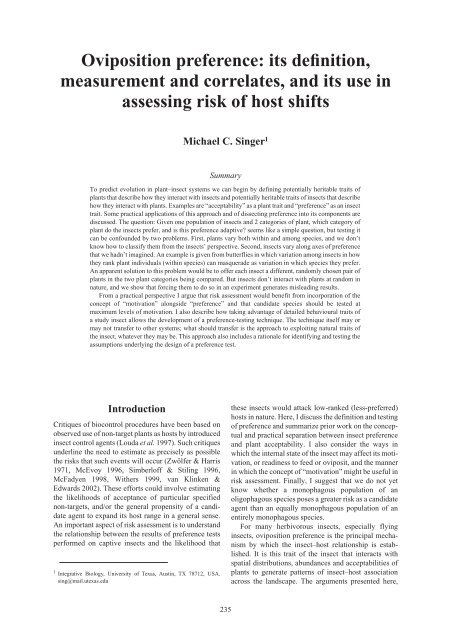

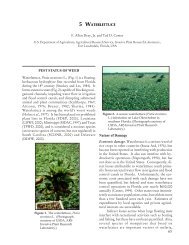

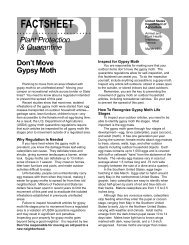
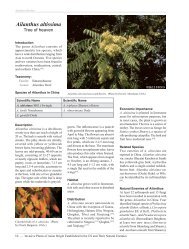
![A Guide to the Control and Management of Invasive Phragmites [PDF]](https://img.yumpu.com/27321025/1/190x190/a-guide-to-the-control-and-management-of-invasive-phragmites-pdf.jpg?quality=85)
